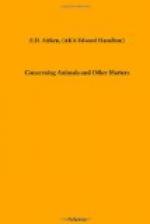If we turn next to the Ruminants, the clean beasts which chew the cud and divide the hoof, the puzzle becomes harder still. Deer and antelopes are often kept as pets, and become so tame that they are allowed to wander at liberty. In Egypt herds of gazelles were so kept before the days of Cheops. In India I have known a black buck which regularly attended the station cricket ground, moving among the nervous players with its nose in the air and insolence in its gait, fully aware that eighteen-inch horns with very sharp points insured respectful treatment. Mr. Sterndale trained a Neilghai to go in harness. The great bovine antelopes of Africa would become as tame, and there is no reason to suppose that their beef and milk would not be as good as those of the cow. But no antelope or deer appears ever to have been domesticated, with the exception of the reindeer.
Of the other ruminants the ox, buffalo, yak, goat, sheep and a few others are domestic animals, while the bison and the gaur, or so-called Indian bison, and a large number of wild goats and sheep have been neglected. The buffalo and yak have probably come under the yoke in comparatively recent times, for they are little changed; but the goat and still more the sheep have undergone a wonderful transformation within and without. Who could recognise in a Leicester ewe the wary denizen of precipitous mountains which will not feed until it has set a sentinel to give warning if danger approaches? And here is a curious fact which has scarcely been noticed by naturalists.
The original of our goat is supposed to be the Persian ibex. At any rate, it was an ibex of some species, as its horns plainly show. But on the plains of Northern India, under ranges of hills on which the Persian ibex wanders wild, the common domestic goat is a very different animal from that of Europe, and has peculiar spiral horns of the same pattern as the markhor, another grand species of wild goat which draws eager hunters to the higher reaches of the same mountains. From this it would appear that two species of wild goat have been domesticated and kept to some extent distinct, one eventually finding its way westward, but not eastward and southward.
The Indian humped cattle also differ so widely in form, structure and voice from those of Europe that there can scarcely be a doubt of their descent from distinct species. But both have entirely disappeared as wild animals, unless indeed the white cattle of Chillingham are really descendants of Caesar’s dreadful urus and not merely domestic cattle lapsed into savagery. So have the camel, and, with a similar possible exception, the horse. Was the whole race in each of these cases subjugated, or exterminated, and that by uncivilised man with his primitive weapons? There is no analogy here with the extinction of such animals as the mammoth, for the ox is a beast in every way fitted to live and thrive in the present condition of this world, as much so as the buffalo and the Indian bison, which show no sign of approaching extinction. Our fathers easily got rid of the difficulty by assuming that Noah never released these species after the Flood, but what shall those do who cannot believe in the literality of Noah’s ark?




